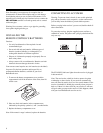
5
PREPARATION
Caution:
Make all the necessary connections before you plug in
or turn on the receiver.
POSITIONING SPEAKERS
Speaker (not supplied) placement can make a noticeable
difference in your system’s sound. The guidelines in this
section will help you choose the best locations. After you use
your receiver for a while, you might want to try different
locations for your speakers.
Bass response depends largely on speaker location. For strong
bass, place the speakers in the corners of the room. If you want
even stronger bass, place the speakers directly on the floor. If
the bass is too strong, move the speakers slightly away from
the corners of the room, or raise them 6 to 18 inches off the
floor. You can buy speaker stands at your local RadioShack
store.
The distance between the speakers should be about the same as
the distance between the normal listening point and the point
halfway between the speakers. If you place the speakers too
close together, you reduce the stereo separation. If you place
them too far apart, you reduce the bass effect and create a
hole
in the middle of the sound.
Most speakers have a tweeter dispersion angle of about 60
degrees. Ideally, your listening position should be just inside
the overlap area of the tweeter dispersion. You can angle the
speakers toward you for better stereo effect.
CONNECTING SPEAKERS
Follow these guidelines when you select and connect speakers.
• Only connect speakers that are rated at between 8 and 16
ohms.
• Be sure you properly connect all speakers.
• Do not connect two pairs of speakers to a single set of
terminals (A or B) at the same time. When you use two
pairs of speakers, connect one pair to the A SPEAKERS
terminals and the other pair to the B SPEAKERS
terminals.
• Optimus, and other high-quality speakers have color-
coded speaker terminals (red for positive polarity and
black for negative polarity). Use these color-coded
terminals as a guide to help you properly connect the
speakers to the receiver.
Use 16-gauge (or larger) speaker wire for all speaker
connections, and consider possible speaker locations before
you decide how much speaker wire you need.
Preparing the Speaker Wires
Speaker wire consists of two conductors (individual wires)
encased in insulation and is usually color-coded or marked
with a ridge along one side so you can identify each conductor.
Use these markings as a guide to help you properly connect the
speakers to your receiver.
Follow these steps to prepare the speaker wires.
1. Cut the speaker wires to the necessary length.
2. Separate the wires about 4 inches on each end.
3. Using a wire stripper, carefully strip about
3
/
4
inch of
insulation from the end of each conductor.
4. Twist the end of each conductor to secure any loose wire
strands.
Caution: Twisting the end of each conductor helps prevent
a short circuit because stray speaker wire strands do not
touch other speaker terminals or any other receiver
terminals.
Connecting Speakers to the A and B Terminals
Note:
• Be sure you connect the receiver’s right and left positive
(+) and negative (–) terminals to the speaker’s
corresponding right and left positive (+) and negative (–)
terminals.
• Fully insert the speaker wires to ensure a good connection.
Leave extra wire at the back of the receiver so you do not
disconnect the wires when you move the receiver.
Follow these steps to connect each speaker (
A
right or left or
B
right or left).
1. Press open the receiver’s positive (
+
) red lever for the
speaker you want to connect and insert the ridged or color-
coded conductor’s end into the small hole. Release the
lever to secure the conductor.


















